
Conversation

🥳 Feedback Received!
Thanks for taking a moment to share your thoughts — it genuinely helps us make each chapter sharper.
What happens next:
- Your feedback goes straight to our product team.
- We’ll use it to refine lessons, clarify examples, and make the program even more useful.
Appreciate you helping make this program better for everyone.
Ready for your next challenge? 👇
Editorial/SEO
Editorial/SEO strategies take a data-driven approach to content: brands choose topics to create content about based on search trends and user behavior.
Below, we’ll focus mostly on creating text-based content for Google, but many tactics apply to other content formats. For more technical on-page and off-page optimization strategies, we advise going through our SEO unit.
What does excellent editorial/SEO content look like?
Content in this strategy is usually:
- More educational than promotional: Users search because they want information. Editorial/SEO content satisfies this by giving information on topics people care about.
- Easy to consume: If content is hard to read or understand, chances are a user will leave a site very quickly—bad for SEO because Google looks at user experience signals to understand content quality.
- Original: Many articles paraphrase existing content with few original contributions. But involving true subject matter experts makes content more valuable and helps it earn shares and backlinks. (Websites with more quality backlinks, or links from another website, usually perform better in search results.)
Some so-called SEO experts claim a few easy tricks as the key to higher search rankings. According to them:
- Long-form content ranks better than short-form content.
- Keyword density—the number of times a keyword appears in a piece of content—matters.
- Conceptually related keywords matter.
These are myths. There are no shortcuts to better rankings, although Google’s Webmaster guidelines do offer a list of bad optimization techniques to avoid. The main gist behind them: avoid creating any content that doesn’t actually help the user.
How to create excellent content
Google’s ranking factors are always changing. In spite of this, we’ve identified seven tactics that help drive SEO success:
- Use keyword research to guide content creation.
- Choose keywords based on relevance and intent.
- Categorize keyword data into topic clusters.
- Target a mix of keywords.
- Establish editorial consistency.
- Optimize content for user experience.
- Focus on content depth.
We’ll discuss each in more detail below.
Use keyword research to guide content creation.
Companies do keyword research to find out topics that users are interested in.
Two important pieces of info during this process:
- Search volume: The average number of searches for a topic within a certain time frame, usually a month. This number changes over time.
- Difficulty: How hard it is to create content that ranks for a specific keyword. This is also known as keyword competition.
SEO tools like Ahrefs, Semrush, and Moz can help identify keywords worth targeting based on search volume and difficulty.
You can also gauge the difficulty of a keyword by looking at the first page of its search results. Three rules of thumb:
- The higher the total number of results, the more difficult a keyword phrase tends to be.
- If there are ads at the top of search results, the keyword phrase is harder to rank for.
- If Reddit posts and Quora questions appear on the first page of search results, chances are the topic isn’t very competitive. Very targeted landing pages usually appear for the most difficult topics.
Choose keywords based on relevance and intent.
Search volume and difficulty are a good starting point for deciding which keywords to create content about. However, you should also consider keyword relevance and search intent.
- Relevance: How closely a specific keyword or topic relates to your product
- Search intent: The user’s purpose behind a specific query. There are four types:
- Informational: The user searches for content because they’re looking for information about a subject, e.g., your industry, the problem your product solves, the benefits of solving it, etc.
- Commercial investigation: The user isn’t ready to make a purchase yet but is looking for content to help get there, e.g., product reviews and comparison guides.
- Transactional: The user is ready to make a purchase. Sales pages with contact forms are best for this intent.
- Navigational: The user searches to get to a specific website, e.g., searching a company’s name to find its website or YouTube channel.
Categorize your keyword data based on relevance (high, medium, low) and search intent. For new companies, it’s best to prioritize keywords with high relevance and either informational or commercial investigation intent.
Content that targets these keyword phrases has a better chance of bringing in visitors that will actually benefit from your product.
Categorize keyword data into topic clusters.
As you go through your keyword data, you’ll probably notice very similar phrases. Since users search for topics using different wording, some phrases are variations with the same intent. In these cases, a single piece of content can target all of them.
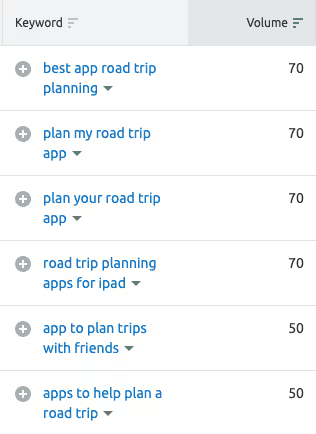
Here’s how to organize your keyword data into topic clusters:
- Group related keywords. Keywords belong in the same cluster if the intent behind them is identical or very similar.
- In each cluster, identify the primary keyword. This keyword is the overarching theme of the cluster, and is usually the keyword with the highest search volume.
- For the other keywords, categorize them as secondary and tertiary keywords. These are the keywords that relate to the primary one but have lower search volume and relevance.
For example, check out this topic cluster about sending money abroad:
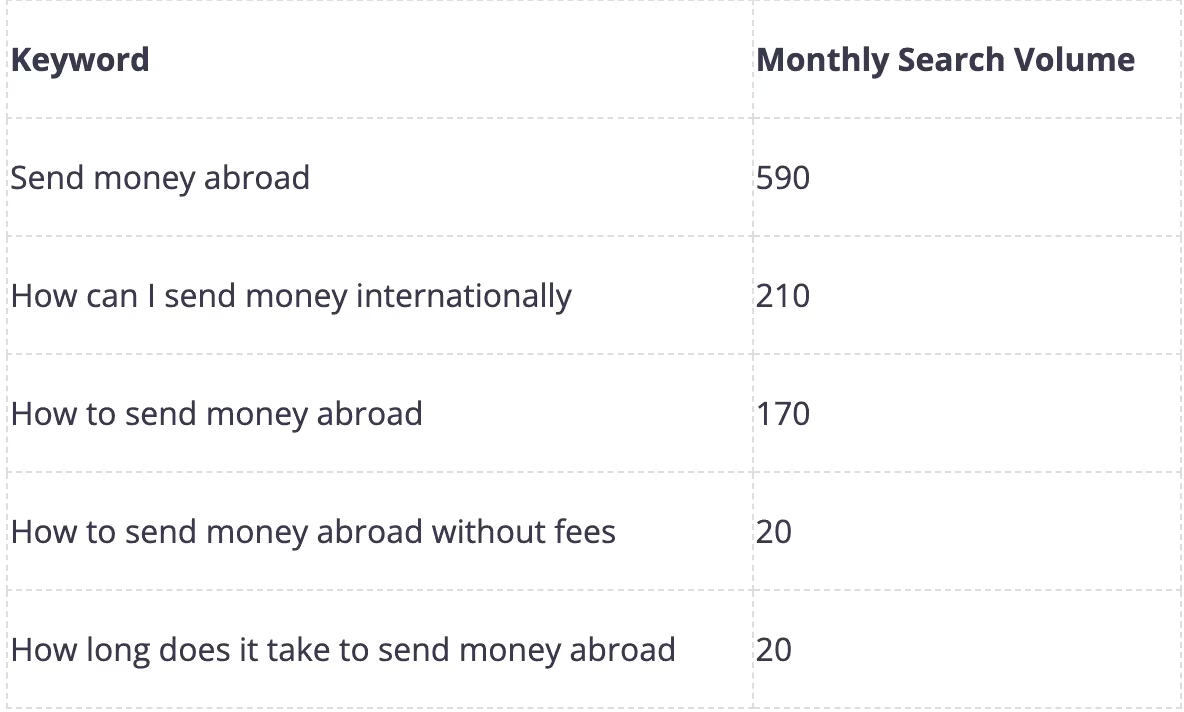
Based on this data, it makes sense to create content targeting “send money abroad” as your primary keyword. Related keywords like “how to send money abroad without fees” and “how long does it take to send money abroad” are less popular but still relevant, so they should be secondary/tertiary keywords.
Target a mix of keywords.
Marketers typically target either keywords with high search volume or keywords with low difficulty.
It’s hard to find keywords that fit both—aka popular keywords (high search volume) that aren’t competitive (low difficulty). This usually happens with new, trending topics, which quickly become more difficult to rank for as people rush to create content.
We don’t advise either strategy because:
- Keywords with high search volume tend to be more competitive. These are the popular queries with thousands of searches per month. More companies target them, making it hard for new websites to create content that ranks.
- Keywords with low difficulty tend to be more niche phrases. Fewer brands target them because interest in these topics tends to be lower.
Instead, target a mix of keywords for a more balanced SEO strategy.
Establish editorial consistency.
Your content is more likely to succeed if you set some editorial standards.
Three places you need consistency:
- Branding: Your company’s voice, tone, and style
- Quality: Your writing’s structure, detail, and accuracy
- Publishing: When your content is scheduled
Your publishing schedule depends on how often you can create content that meets these standards. Having a set schedule helps to develop a loyal following, but you should never publish content at the expense of quality.
Some people believe that the more often they publish content, the better—but this big misconception downplays content quality. If you trade quality for frequency, your content is more likely to be mediocre.
Optimize content for user experience.
The more user-friendly your content, the longer users will stick around.
To make content more user-friendly:
- Answer your target keyword’s intent. Place the most important information toward the beginning of your content. Visitors shouldn’t need to go back to Google’s search results after reading your content.
- Link to reputable resources. Don’t direct users to sites with malware or inaccurate information.
- Focus on readability. Break up your content with headings, numbered/bullet lists, and line breaks. If it’s a long piece of content, include a table of contents. Also use images and videos to support your key points.
- Make your website easy to navigate. Use a clear navigation menu and link internally within your content. Also incorporate a search bar for users’ convenience.
- Use a responsive design. A responsive web design automatically adjusts to screen size so that users can enjoy a page’s content regardless of what type of device they use.
- Improve page speed. The faster your page speed, the better—Google’s bots will be able to index more pages and users won’t leave impatiently. Analyze your content’s current load time with Google’s PageSpeed Insights.
Focus on content depth first.
No matter your niche size, we recommend creating content on a very narrow scope of topics early on.
For instance, instead of creating content about learning a new language, hone in on learning Spanish specifically. Use Answer the Public to find the most common questions being asked about your topic. Then focus on answering them thoroughly.
There are two advantages to this:
- There are more interlinking opportunities. It’s easier to link internally between highly related content on your site than content that relates only peripherally. This matters because internal links make it easy for both users and search engine crawlers to navigate around a site.
- You’ll become the authority for a specific niche faster. Covering every angle of Topic X gives you more credibility than if you shallowly covered Topics X, Y, and Z. You’ll be a specialist rather than a jack of all trades.
Once you’ve fully covered a topic, branch into related ones. The key is identifying topics that are highly relevant to your product.
How to optimize your results
Success with this strategy requires continued focus on your content and industry, plus SEO.
For better results:
- Conduct content audits. Review your content’s performance regularly to find out which pieces of content have moved in search rankings. Also find out what new keywords your content ranks for and what keywords it’s lost.
- Revisit old content. Updating old content can have better ROI than creating new content—so make an action plan for older content based on your audit. Potential changes include:
- Fixing broken links and typos
- Adding new information, links, images, videos, or other relevant content
- Deleting outdated, irrelevant, or redundant content
- Rewriting for more clarity
- Consolidating content from different pages
- Monitor your industry. Your industry is a good source for new, relevant topics to create content about. Follow the news about what’s going on and keep tabs on your competitors.
- Stay up-to-date on SEO news. Subscribe to authority publications about SEO, like Search Engine Journal and Search Engine Land, and follow Google’s Search Liaison on Twitter.
Examples of effective editorial/SEO content
Rover.com
The dog boarding and walking app Rover.com creates optimized content for its blog and YouTube channel.
According to Semrush, its website ranks for more than 775,000 keywords, including:
- dogs that don’t shed (90,500 searches per month)
- can dogs eat popcorn (40,500 searches per month)
- eye drops for dogs (14,800 searches per month)
A lot of this content is helpful and educational, with the goal of answering new dog owners’ questions about their pets. This is the same on Rover.com’s YouTube channel, which has more than 1.1 million views and videos like “How to Measure Your Dog for Clothing.”
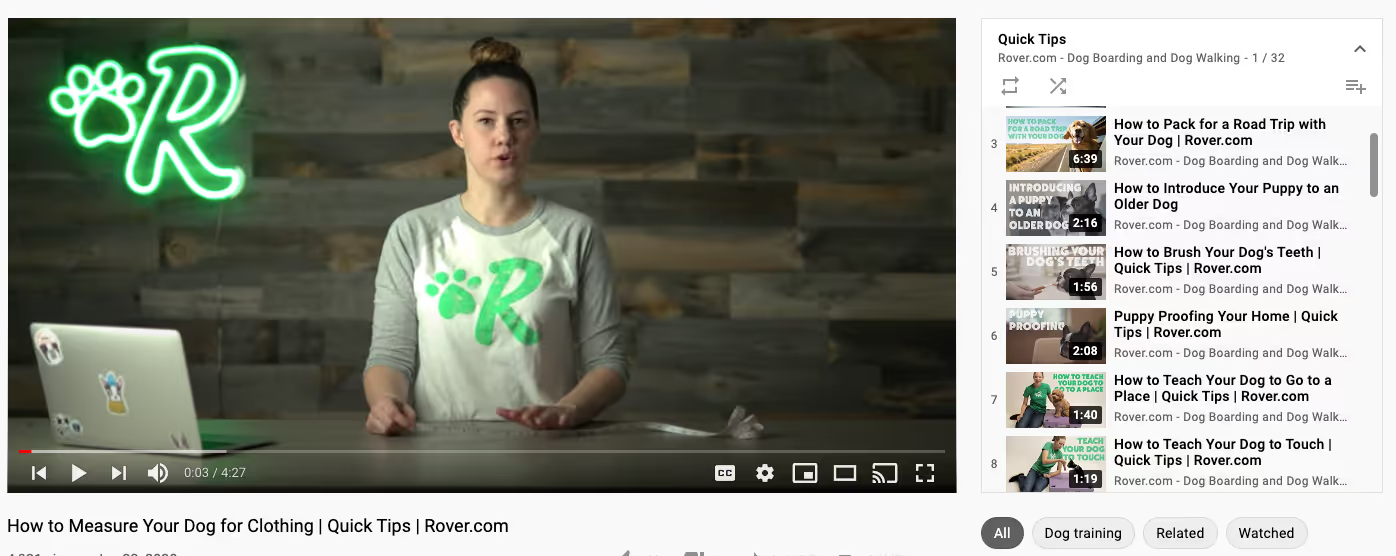
Chances are that anyone looking for advice on caring for a dog will come across Rover.com’s content, either on its blog or YouTube, because of how keyword-targeted it is.
Skillshare
Many people who want to pick up a new creative hobby first turn to Google for answers. The learning platform Skillshare capitalizes on this by creating educational blog posts about art and design, all optimized for the most popular search queries.
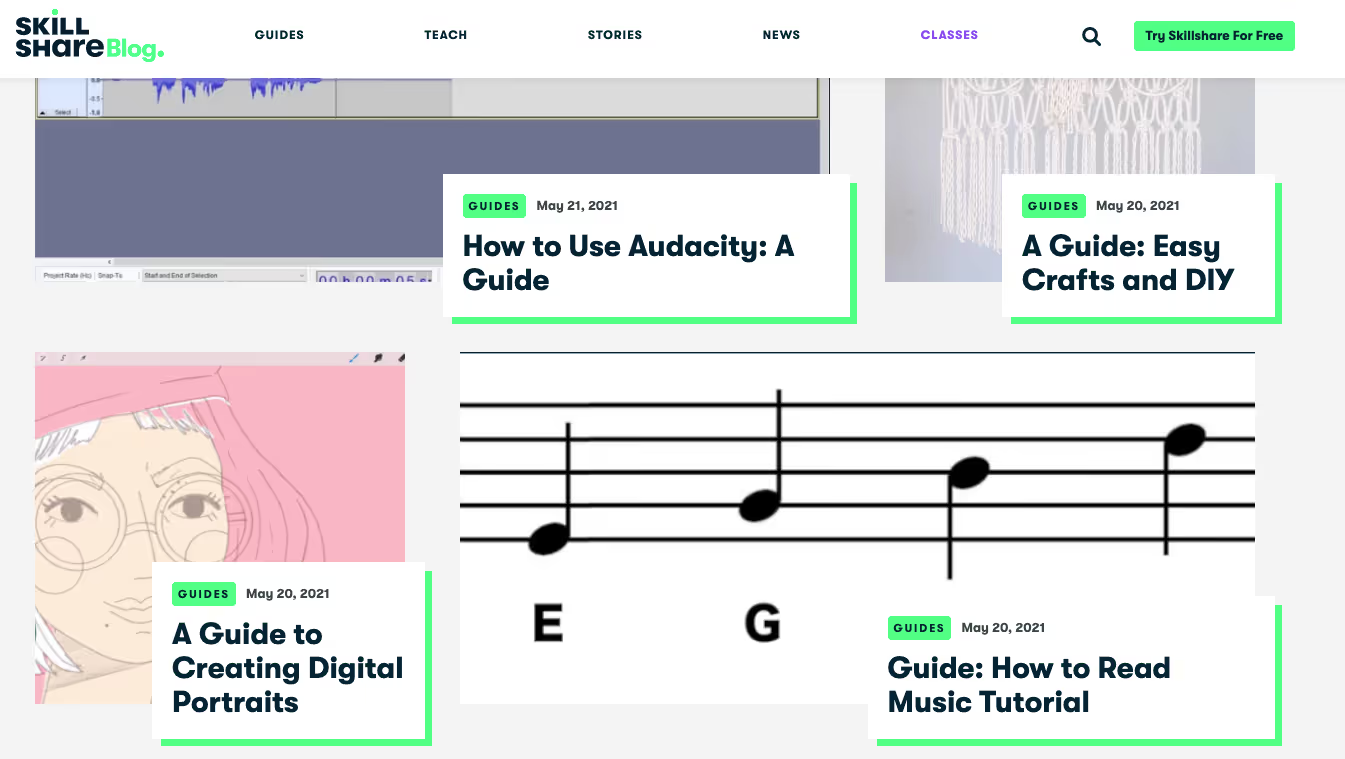
For example, here are the titles of a few of its top-ranking posts and what they rank for:
- “The 9 Best Animation Software for Beginners and Beyond” – ranks for “animation software”
- “The Narrative Technique Guide: 25 Examples and Explanations That’ll Make You a Better Reader and Writer” – ranks for “narrative techniques”
- “85 Very Adorable, Cute & Easy Drawings to Make” – ranks for “cute simple drawings”
The result: Skillshare’s site ranks for more than 31,000 keywords related to painting, cinematography, and many more creative activities. And by targeting these keywords, Skillshare reaches more of its target clientele—people interested in developing their skills in creative subjects.
Fitbit
Many people who want to start getting into shape first turn to Google for answers. Fitbit capitalizes on this by creating educational blog posts about fitness and health, all optimized for the most popular search queries.
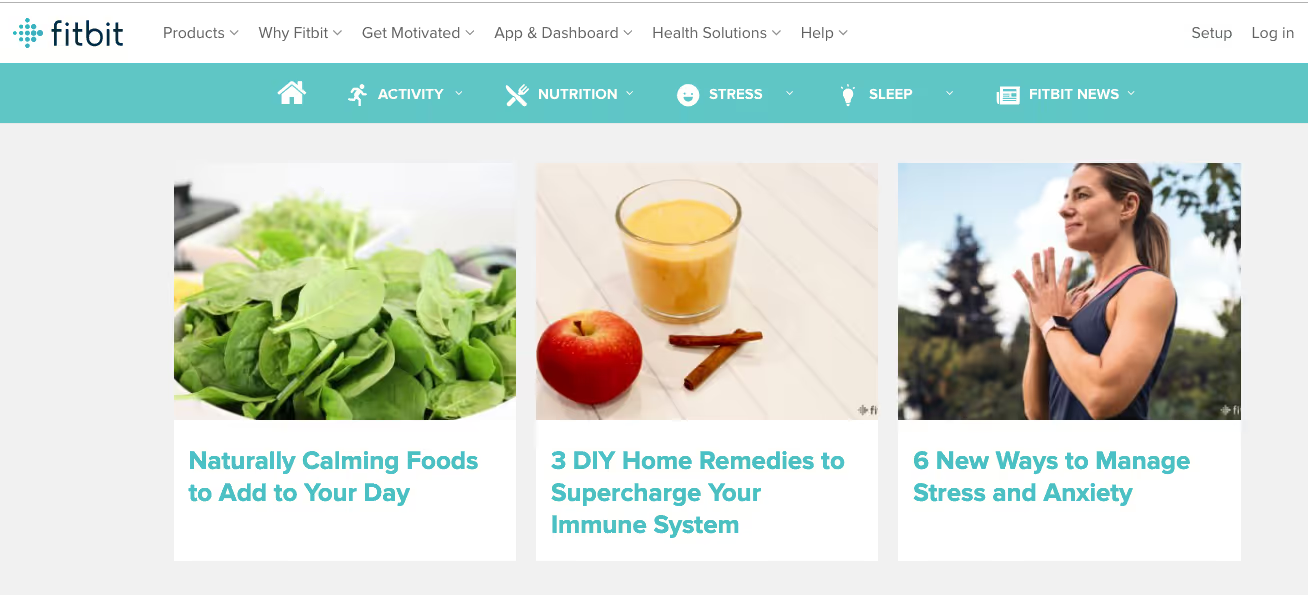
According to Semrush, Fitbit’s blog ranks for more than 62,400 keywords, including:
- weight loss meal plan (49,500 searches per month)
- high protein breakfast (27,100 searches per month)
- medicine ball exercises (8,100 searches per month)
Chances are that anyone looking for health and wellness information will come across Fitbit’s content. By targeting these keywords, Fitbit establishes its brand as an authority in the health and fitness niche—and it makes a stronger case for why people should try out its product.
Stitch Fix
Like health and fitness, fashion is a topic that many people search for answers to online, especially when it comes to making style decisions.
To get in front of these users, Stitch Fix focuses its content strategy on SEO. Although it publishes a few topical posts (e.g., “Women’s Summer 2021 Fashion Trends: Your Guide”), most of its blog is optimized around providing evergreen fashion tips and answering styling questions.

For example, here are the titles of a few of its top-ranking posts and what they rank for:
- “Men’s Wedding Guest Outfits” – ranks for “mens wedding guest outfit”
- “How to Dress For Any Graduation” – ranks for “what to wear to a graduation”
- “Semi-Formal Wedding Attire For Men: A Complete Guide” – ranks for “semi formal wedding attire”
The result: Stitch Fix’s blog ranks for more than 87,000 keywords related to fashion. And by targeting these keywords, Stitch Fix reaches more of its target clientele—people who aren’t so knowledgeable about fashion and would maybe rather use a styling service.
Ahrefs
Ahrefs’ content marketing strategy revolves around creating optimized content for its blog and YouTube channel.
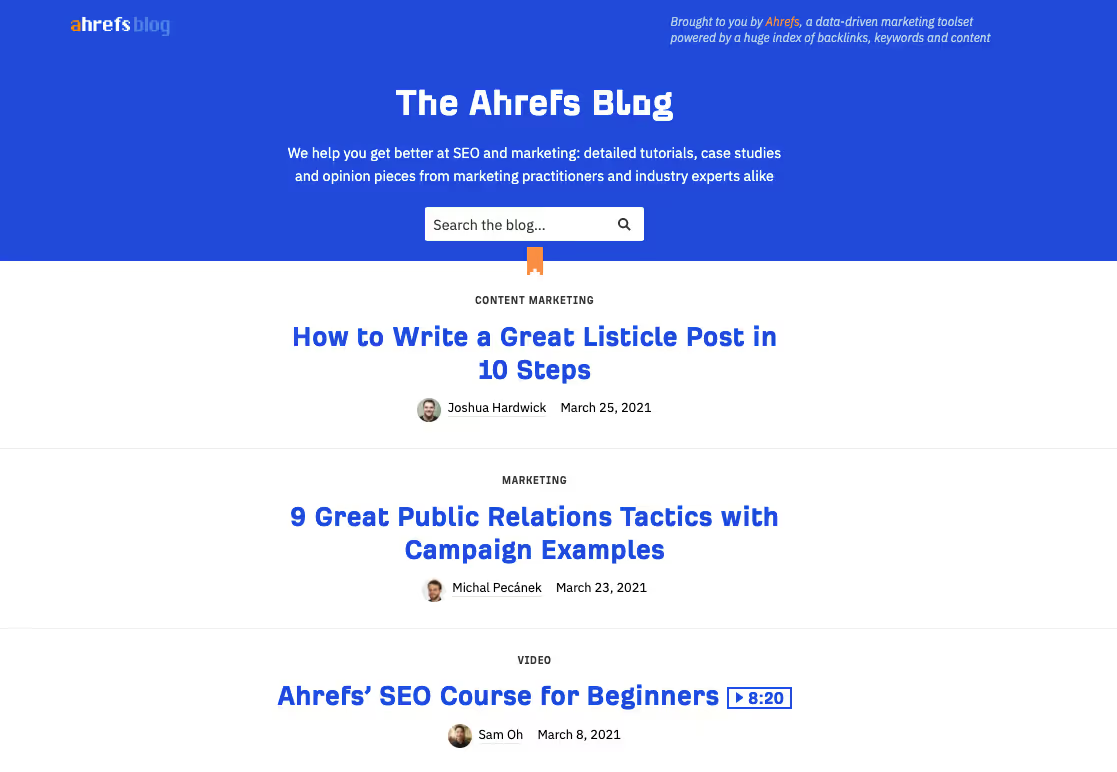
According to Semrush, its website ranks for more than 78,000 keywords, including:
- affiliate marketing (74,000 searches per month)
- google keyword planner (40,500 searches per month)
- backlinks (8,100 searches per month)
Ahrefs’ YouTube channel also has more than 10 million views and 218,000 subscribers, with videos showing on the first page for searches about SEO.
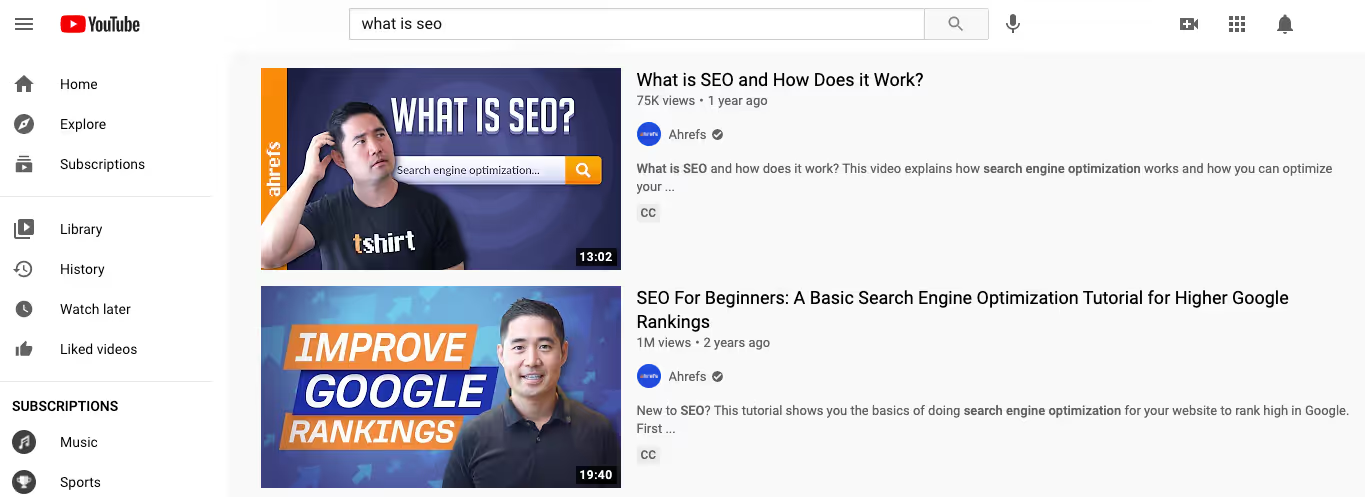
Chances are that anyone looking for SEO and digital marketing tutorials will come across Ahrefs’ content because of its excellent optimization.
Coschedule
According to Semrush, CoSchedule’s site ranks for more than 77,000 keywords, the majority of which are for CoSchedule’s blog posts.
Some of these posts feature lead magnets—pieces of content that readers can access if they fill out a form.
One example: CoSchedule’s social media content calendar template. Users just need to provide their name, email, and company information to get it.
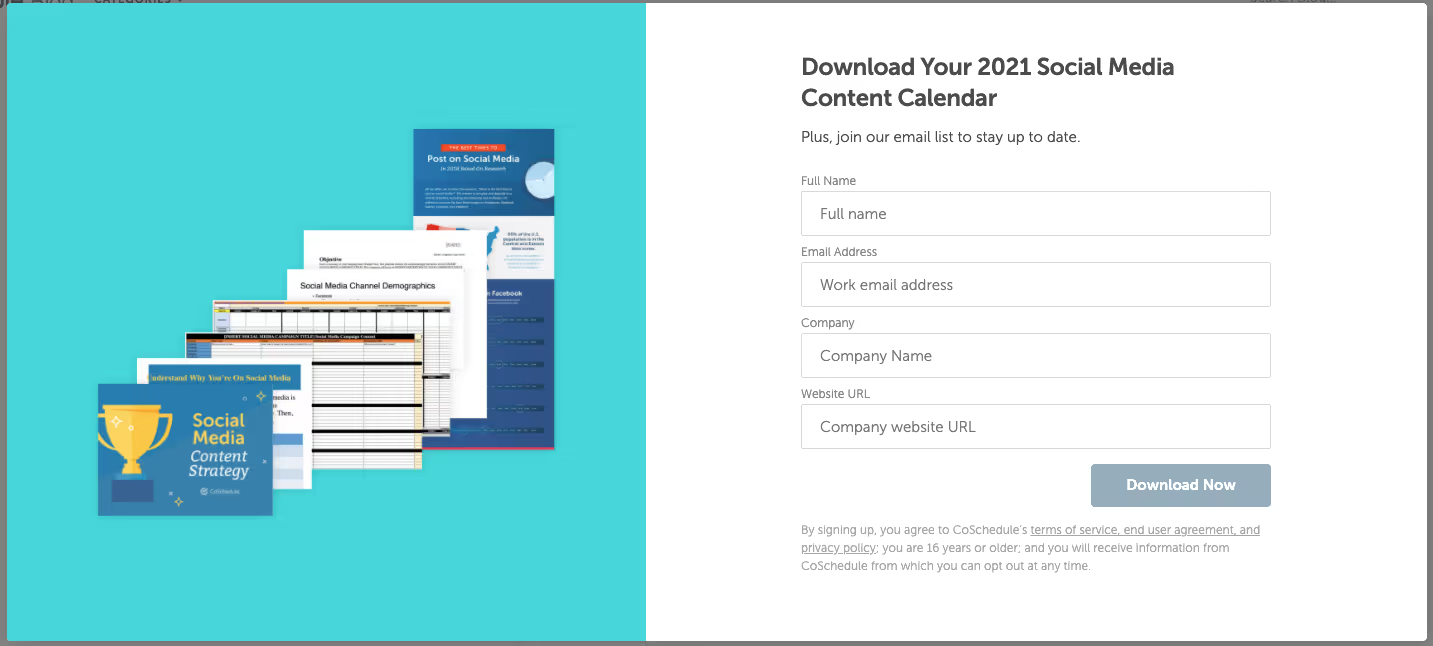
The page ranks highly for 693 organic keywords, including:
- social media calendar (6,600 searches per month)
- social media content calendar (3,600 searches per month)
- social media calendar template (3,600 searches per month)
- social media content calendar template (1,300 searches per month)
The best part: social media calendars relate to CoSchedule’s product, a calendar software. So someone searching for a social media calendar is probably a great candidate to try out CoSchedule—and coming across its blog post leads them there.


